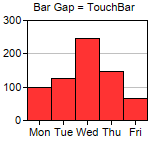
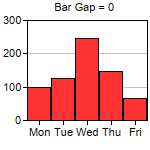
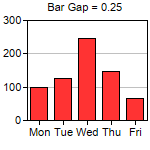
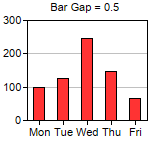
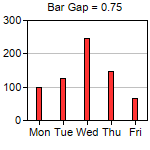
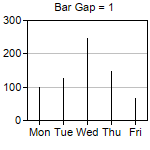
This example demonstrates the effects of different bar gaps configured using BarLayer.setBarGap.
ChartDirector 7.0 (Python Edition)
Bar Gap
Source Code Listing
#!/usr/bin/python
# The ChartDirector for Python module is assumed to be in "../lib"
import sys, os
sys.path.insert(0, os.path.join(os.path.abspath(sys.path[0]), "..", "lib"))
from pychartdir import *
def createChart(chartIndex) :
bargap = chartIndex * 0.25 - 0.25
# The data for the bar chart
data = [100, 125, 245, 147, 67]
# The labels for the bar chart
labels = ["Mon", "Tue", "Wed", "Thu", "Fri"]
# Create a XYChart object of size 150 x 150 pixels
c = XYChart(150, 150)
# Set the plotarea at (27, 20) and of size 120 x 100 pixels
c.setPlotArea(27, 20, 120, 100)
# Set the labels on the x axis
c.xAxis().setLabels(labels)
if bargap >= 0 :
# Add a title to display to bar gap using 8pt Arial font
c.addTitle(" Bar Gap = %s" % (bargap), "Arial", 8)
else :
# Use negative value to mean TouchBar
c.addTitle(" Bar Gap = TouchBar", "Arial", 8)
bargap = TouchBar
# Add a bar chart layer using the given data and set the bar gap
c.addBarLayer(data).setBarGap(bargap)
# Output the chart
c.makeChart("gapbar%s.png" % chartIndex)
createChart(0)
createChart(1)
createChart(2)
createChart(3)
createChart(4)
createChart(5)